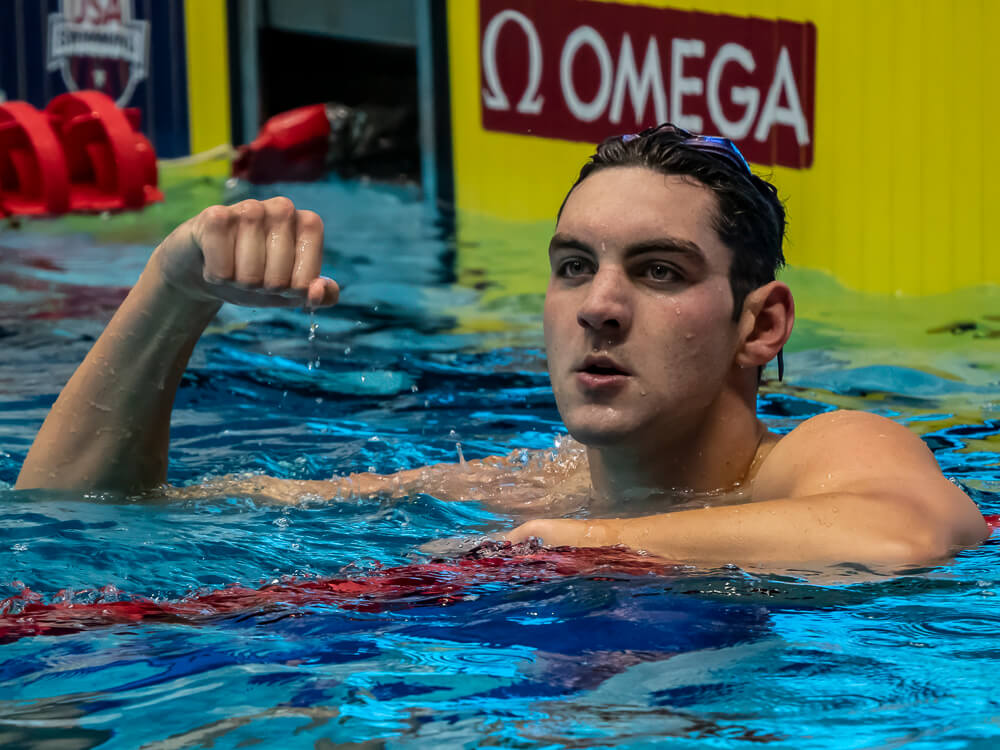World Championships Relay Analysis: No Dressel, No Problem for U.S. Men’s 400 Free Relay?

World Championships Relay Analysis: No Dressel, No Problem for U.S. Men’s 400 Free Relay?
The first time Nathan Adrian swam on the finals squad of a U.S. men’s 400 free relay team, he pulled off an unlikely gold medal. At the 2009 World Championships, Adrian took down Russia and favored France for gold, the second consecutive year with a dramatic American victory after the legendary finish provided by Jason Lezak at the Beijing Olympics.
That was the last time the American men won a world or Olympic title in the 400 free relay without Caeleb Dressel on the team. Dressel is actually undefeated when taking part in the event, with Olympic golds in Rio de Janeiro, Tokyo and Paris plus world titles in 2017, 2019 and 2022. But with Dressel absent at the 2023 World Championships, an American team with three rookies on board struggled against tough competition from Australia and Italy, finishing with bronze. If not for Great Britain’s disqualification in prelims, the American team might have missed the podium entirely.
Dressel is not part of this year’s group bound for the World Championships in Singapore, but the status quo has changed considerably in the last two years. The rookies who guided the team in Fukuoka, Japan, have received plenty of seasoning in the past two years. Of the 16 men who have cracked 53 this year, half are Americans. Only one other country has two swimmers under 48 thus far in 2025.
Unsurprisingly, the numbers suggest a global blowout in favor of the Stars and Stripes. Below are the added-up times for the top countries in this event. Only 2025 season-best times are used here, but limitations of this analysis will be considered.
- United States: Jack Alexy 46.99 + Patrick Sammon 47.47 + Chris Guiliano 47.49 + Destin Lasco 47.58 = 3:09.53
- Australia: Kyle Chalmers 47.27 + Flynn Southam 47.69 + Max Giuliani 48.34 + Kai Taylor 48.37 = 3:11.67
- Neutral Athletes B (Russia): Egor Kornev 47.42 + Andrei Minakov 48.16 + Vladislav Grinev 48.17 + Vasilli Kukushkin/Ivan Girev 48.42 = 3:13.17
- France: Maxime Grousset 47.50 + Rafael Fente Damers 48.02 + Nans Mazellier 48.21 + Ethan Dumesnil 48.76 = 3:12.49
- China: Pan Zhanle 47.77 + Chen Juner 48.00 + Wang Haoyu 48.36 + Liu Wudi 48.43 = 3:12.55
- Great Britain: Matt Richards 47.92 + Jacob Mills 48.03 + Alexander Cohoon 48.23 + Tom Dean 48.40 = 3:12.58
- Germany: Josha Salchow 48.02 + Rafael Miroslaw 48.36 + Kaii Winkler 48.41 + Luca Armbruster 48.82 = 3:13.61
- Italy: Thomas Ceccon 48.17 + Manuel Frigo 48.34 + Alessandro Miressi 48.56 + Lorenzo Zazzeri 48.57 = 3:13.64
- Canada: Ruslan Gaziev 48.37 + Antoine Sauve 48.42 + Josh Liendo 48.62 + Filip Senc-Samardzic 49.13 = 3:14.54
That is a two-second advantage for the United States. Jack Alexy is the only swimmer to swim a 46 so far this year, but he is not alone with the likes of Patrick Sammon, Chris Guiliano and Destin Lasco having gone 47-mid times at Nationals. And even if one of those swimmers falter, there are three other really strong options on the team with Jonny Kulow, Shaine Casas and Henry McFadden all members of the team with sub-48 performances to their credit. With a two-second advantage in the composite times, a slight drop-off will not crush gold-medal hopes.
Rather, the American quartet matching their Nationals times plus adding in relay starts could produce a challenge to the world record. The 3:08.24 mark has survived since the aforementioned Beijing final, and no one has come close since. This powerful American team could have a chance, although the likely lack of challengers in Singapore adds to the degree of difficulty.
Behind the U.S., the Australians look like the safest bet to reach the podium here. Kyle Chalmers has won a medal every time he has taken part on this relay in global-level competition, and come-from-behind heroics on the anchor leg have become the norm. Chalmers, who turns 27 later this month, has posted the fastest split of any country in the finals at the last two Olympics as well as the 2022 and 2023 World Championships. He has a strong No. 2 swimmer in Flynn Southam while Kai Taylor has gained experience over the past few years and Max Giuliani has surged this season.
For the first time since Russia was exiled from international competition following the country’s invasion of Ukraine, a large contingent of Russian swimmers will compete at a global long course competition under the title “Neutral Athletes B.” This group is likely to challenge for a medal: Egor Kornev established himself as an individual contender in the 100 free when he blasted a time of 47.42 earlier this year while Andrei Minakov and Vladislav Grinev are solid supporting pieces.
China only has the fifth-best composite time, but that’s with Pan Zhanle sitting at 47.77 this year. Pan, of course, set the world record in the 100 free with a time of 46.40 in the individual Olympic final, and solid support from his countrymen capable of 47-high splits could yield a medal. France has Maxime Grousset leading the way along with a solid contingent of 48-second swimmers. Also dangerous is Great Britain, with veterans Matt Richards and Tom Dean at the forefront of the squad and Duncan Scott always capable of blasting a 47-mid performance.
Germany has built some depth with Josha Salchow as the headliner and a pair of U.S. college-trained swimmers, Rafael Miroslaw and Kaii Winkler, not far behind. Italy always expects results from Thomas Ceccon while Manuel Frigo secured Olympic bronze with his 47.06 anchor split, but the team will need Alessandro Miressi to get back under 48 for a realistic medal chance.



